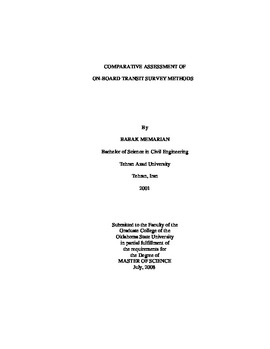| dc.contributor.advisor | Jeong, Hyungseok (David) | |
| dc.contributor.author | Memarian, Babak | |
| dc.date.accessioned | 2014-04-17T19:56:16Z | |
| dc.date.available | 2014-04-17T19:56:16Z | |
| dc.date.issued | 2008-07-01 | |
| dc.identifier.uri | https://hdl.handle.net/11244/10148 | |
| dc.description.abstract | On-board Transit Survey is a specific type of surveys conducted on transit units like buses to obtain vital information regarding customer trip characteristics, travel behavior, demographic characteristics, and customers attitude toward services. Survey results are used for current or future route planning, modeling, etc. Applying an appropriate conducting method is crucial to collect the required amount of data to fulfill transit systems current and future needs without survey cost and time overruns. This study performed a literature review and case studies on various methods of conducting on-board surveys used by different transit systems. In this research, the effect of: 1) length of questionnaire, 2) different incentives, and 3) surveyors on the response rate, unit cost, and duration of the survey were tested. These tests were conducted on the selected routes of Tulsa Transit system. Using short questionnaires with six essential origin/destination (O/D) questions obtained the highest response rate with 11.4 and 11.1 percentage points differences compared to questionnaires with 14 (O/D and demographic) questions and 29 (O/D, demographic, marketing, and rating) questions. This questionnaire incurred the lowest unit cost with 25.8 and 23.4 percentage points lower than two other questionnaires. As an incentive, offering a drawing to win 31 days free pass obtained 8.2 higher percentage points response rate compared to offering a two free-ride ticket as an incentive to complete a questionnaire, while it increased the unit cost of the survey by 98.4 percentage points. To conduct the data collection phase, female and male surveyors increased the response rate of the survey by 56.7 and 47.2 percentage points respectively, compared to using boxes. Female and male surveyors increased the unit cost of the survey by 56.2 and 80 percentage points. They also obtained 73.7 and 64.2 percentage points higher daily response rates than the method of using boxes, respectively. Results indicate that, when a high response rate is critical a survey with six essential O/D questions offering a drawing to win 31 days free pass distributed by female surveyors can be the best combination. When the cost of survey is critical, a survey with six essential O/D questions offering a two free-ride ticket distributed by using boxes can be the best option. If the survey duration is critical and the survey has to be conducted under a limited timeframe, a survey conducted by female surveyors can be the best method while using male surveyors can be an alternative method of data collection. | |
| dc.format | application/pdf | |
| dc.language | en_US | |
| dc.publisher | Oklahoma State University | |
| dc.rights | Copyright is held by the author who has granted the Oklahoma State University Library the non-exclusive right to share this material in its institutional repository. Contact Digital Library Services at lib-dls@okstate.edu or 405-744-9161 for the permission policy on the use, reproduction or distribution of this material. | |
| dc.title | Comparative Assessment Of On-board Transit Survey Methods | |
| dc.type | text | |
| dc.contributor.committeeMember | Oberlender, Garold D. | |
| dc.contributor.committeeMember | Ahmed, Mohamed Samir | |
| osu.filename | Memarian_okstate_0664M_2824.pdf | |
| osu.college | Engineering, Architecture, and Technology | |
| osu.accesstype | Open Access | |
| dc.description.department | School of Civil & Environmental Engineering | |
| dc.type.genre | Thesis | |
